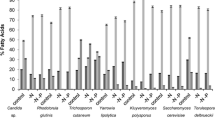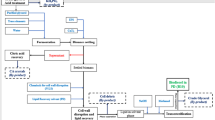Abstract
A mathematical model was constructed to describe the influence of the carbon to nitrogen ratio (C/N-ratio) of the growth medium on lipid production by oleaginous yeasts. To test this model and to determine some relevant model parameters, the oleaginous yeast Apiotrichum curvatum ATCC 20509 was grown in continuous cultures at various C/N-ratios and dilution rates. It appeared that when nitrogen is limiting for the formation of biomass, the remaining glucose can be converted to storage carbohydrate and storage lipid. No clear dependence of carbohydrate yield on the C/N-ratio could be demonstrated, but lipid yield increased gradually with increasing C/N-ratios.
The maximal dilution rate for lipid producing yeast cells appeared to be optimal at relatively low C/N-ratios. It can be concluded that the experimental results fitted well with the mathematical model. By using this model, lipid yield and lipid production rate can be calculated at any C/N-ratio of the growth medium and optimum operation conditions can be predicted for the production of microbial lipids.
Similar content being viewed by others
References
Boulton, C. A. & Ratledge, C. (1981) Correlation of lipid accumulation in yeast with possession of ATP:citrate lyase. J. Gen. Microbiol. 127: 169–176
Boulton, C. A. & Ratledge, C. (1983) Use of transition studies in continuous cultures of Lipomyces starkeyi, and oleaginous yeast, to investigate the physiology of lipid accumulation. J. Gen. Microbiol. 129: 2871–2876
Bruinenberg, P. M., van Dijken, J. P. & Scheffers, W. A. (1983) An enzymic analysis of NADPH production and consumption in Candida utilis. J. Gen. Microbiol. 129: 965–971
Dekkers, J. G. J., de Kok, H. E. & Roels, J. A. (1981) Energetics of Saccharomyces cerevisiae CBS 426: comparison of anaerobic and aerobic glucose limitation. Biotechnol. Bioeng. 23: 1023–1025
Eroshin, V. K. & Krylova, N. I. (1983) Efficiency of lipid synthesis by yeasts. Biotech. Bioeng. 25: 1693–1700
Evans, C. T. & Ratledge, C. (1983) A comparison of the oleaginous yeast, Candida curvata, grown on different carbon sources in continuous and batch culture. Lipids 18: 623–629
Floetenmeyer, M. D., Glatz, B. A. & Hammond, E. G. (1985) Continuous culture fermentation of whey permeate to produce microbiol oil. J. Dairy Sci. 68: 633–637
Gill, C. O., Hall, M. J. & Ratledge, C. (1977) Lipid accumulation in an oleaginous yeast (Candida 107) growing on glucose in single-stage continuous culture. Appl. Environ. Microbiol. 33: 231–239
Glatz, B. A., Hammond, E. G., Hsu, K. H., Baehman, L., Bati, N., Bednarski, W., Brown, D. & Floetenmeyer, M. (1984) Modification of fats and oils. In: C. Ratledge, P. Dawson & J. Rattray (eds), Biotechnology for the oils and fats industry, pp. 163–176. Amer. Oil Chemists' Soc., Monograph 11. AOCS, Illinois.
Hammond, E. G., Glatz, B. A., Choi, Y. & Teasdale, M. T. (1981) Oil production by Candida curvata and extraction, composition and properties of the oil. E. H. Pryde, L. H. Princen & K. D. Mukerjee (eds), New sources of fats and oils, pp. 171–187. Amer. Oil. Chemists' Soc., Monograph 9. AOCS, Illinois.
Kessel, R. H. J. (1968) Fatty acids of Rhodotorula gracilis: fat production in submerged culture and the particular effect of pH value. J. Appl. Bacteriol. 31: 220–231
Kirsten, W. J. (1979) Automatic methods for the simultaneous determination of carbon, hydrogen, nitrogen and sulfur, and for sulfur alone in organic and inorganic materials. Anal. Chem. 51: 1173–1179
Mokrasch, L. C. (1954) Analysis of hexose phosphates and sugar mixtures with the anthrone reagent. J. Biol. Chem. 208: 55–59
Oura, E. (1972) Reactions leading to the formation of yeast cell material from glucose and ethanol. Alkon Keskus Laboratorio Report 8078, Helsinki
Pan, J. G. & Rhee, J. S. (1986) Biomass yields and energetic yields of oleaginous yeasts in batch culture. Biotech. Bioeng. 28: 112–114
Ratledge, C. (1982) Microbiol oils and fats: an assessment of their commercial potential. Prog. Indust. Microbiol. 16: 119–206
Ratledge, C. & Hall, M. J. (1979) Accumulation of lipid by Rhodotorula glutinis in continuous culture. Biotechnol Lett. 1: 115–120
Ratledge, C., Boulton, C. A. & Evans, C. T. (1984) Continuous culture studies of lipid production by oleaginous microorganisms. In: A. C. R. Dean, D. C. Ellwood, C. G. T. Evans (eds), Continuous culture, Vol. 8: Biotechnology, Medicine and the environment, pp. 272–291. Society of Chemical industry, London/Ellis Horwood Ltd., Chichester
Stouthamer, A. H. & Verseveld, H. W. van (1985) Stoichiometry of microbiol growth. In: C. L. Cooney & E. A. Humphrey (eds), Comprehensive Biotechnology, pp. 215–238 Pergamon Press, Oxford/New York.
Yoon, S. H. & Rhee, J. S. (1983) Lipid from yeast fermentation: Effects of cultural conditions on lipid production and its characteristics of Rhodotorula glutinis. J. Amer. Oil Chem. Soc. 60: 1281–1286
Author information
Authors and Affiliations
Rights and permissions
About this article
Cite this article
Ykema, A., Verbree, E.C., van Verseveld, H.W. et al. Mathematical modelling of lipid production by oleaginous yeasts in continuous cultures. Antonie van Leeuwenhoek 52, 491–506 (1986). https://doi.org/10.1007/BF00423410
Received:
Accepted:
Issue Date:
DOI: https://doi.org/10.1007/BF00423410




